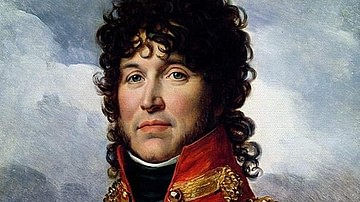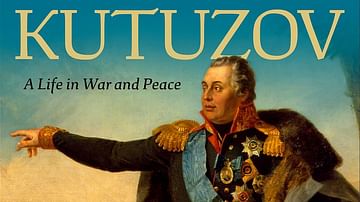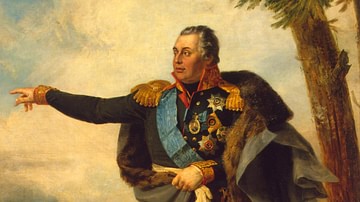The Battle of Austerlitz (2 December 1805), or the Battle of the Three Emperors, was one of the most significant battles of the Napoleonic Wars (1803-1815). It saw French Emperor Napoleon I (r. 1804-1814; 1815) and his Grande Armée decisively defeat a larger Austro-Russian army. Napoleon's victory affirmed French military hegemony in continental Europe for most of the next decade.
The establishment of the First French Empire on 18 May 1804 and the subsequent coronation of Napoleon I stirred up European anxieties over French imperial ambitions. British Prime Minister William Pitt the Younger took advantage of these concerns to organize France's enemies into a Third Coalition, which consisted of the United Kingdom, Austria, Russia, Sweden, Naples, and Sicily, against the French Empire, its client states, and its reluctant Spanish ally. Leading his new Grande Armée across the Rhine, Napoleon won a swift victory against an Austrian army during the Ulm Campaign (25 September to 20 October 1805) and captured Vienna on 13 November 1805.
Upon taking the Austrian capital, Napoleon found his army overextended and faced with a combined Allied army led by the emperors of Austria and Russia. After inducing the Allies to attack him, Napoleon won a decisive battle near the town of Austerlitz in Moravia (modern-day Slavkov u Brna in the Czech Republic), after which the Russians retreated into Hungary and the Austrians sued for peace. The subsequent Treaty of Pressburg (Bratislava) brought Austria out of the War of the Third Coalition, forced it to cede territory to France, and paved the way for the dissolution of the Holy Roman Empire the following year. The Battle of Austerlitz is considered a masterpiece in military tactics and is often ranked among the most important battles in world history.
Capture of Vienna
In August 1805, the Third Coalition began marshaling its armies, with the intention of reducing France to its 1792, pre-war borders. Archduke Charles and 96,000 Austrians were sent into northern Italy, where the Allies assumed the decisive campaign would be fought, while a secondary Austrian army under General Karl Mack von Leiberich was sent into Bavaria, a French ally. Mack's goal was to wait in Bavaria for the arrival of Russian reinforcements, after which the Austro-Russian force would attack Strasbourg and threaten an invasion of France itself. However, the Russian army under Field Marshal Mikhail Kutuzov got off to a late start and was further hindered by the poor quality of Eastern European infrastructure. Mack, for his part, was waiting for the Russians in Ulm, a city far enough away from other Allied armies to make him an easy target.
Napoleon, meanwhile, did not hesitate to respond. Since the resumption of war between France and Britain in May 1803, the French emperor had been gathering an army at Boulogne for an invasion of England. Setting these plans aside, Napoleon instead marched this massive 210,000-man force – soon to be rechristened as La Grande Armée – to the Rhine, which the French crossed on 25 September 1805. Consisting of seven semi-autonomous corps, each with enough provisions to move independently from the main army for a while, the Grande Armée advanced into Germany with remarkable speed; on 7 October, only twelve days after crossing the Rhine, the French reached the banks of the Danube. Mack tried to contest the crossing, but he quickly became overwhelmed by the French numbers. The French enveloped Ulm, trapping the Austrians inside. With Kutuzov's Russian reinforcements still over 160 kilometers (100 mi) away, Mack had no choice but to capitulate. On 20 October 1805, he surrendered his entire army; less than a month after launching his Ulm Campaign, Napoleon had eliminated a major Allied army.

Meanwhile, Kutuzov and his 36,000 Russians reached Braunau on 23 October. Faced with the full might of the Grande Armée, he decided to beat an eastward retreat, hoping to avoid a major battle until he could link up with additional Allied armies. The Russians withdrew toward the Danube, pursued by the French Cavalry Reserve under Marshal Joachim Murat. On 5 November, Prince Peter Bagration beat back the French in a rearguard action near Amstetten; three days later, the Russians crossed the Danube, burning the bridges behind them. Murat gave up the chase, tempted by the "glittering but militarily irrelevant" prize of Vienna, which now lay undefended (Chandler, 405). On 13 November, Murat used trickery to capture the key Tabor bridge, and the French army entered Vienna the next day; on the night of the 14th, the triumphant Napoleon slept in the Habsburg palace of Schönbrunn.
Abandoning the Heights
Yet despite his recent successes, Napoleon was in a fragile position. He was deep enough into enemy territory that his army was dangerously extended since men were needed to garrison towns or guard the supply line back to France; by late November, he only had 75,000 available troops. The strength of the Coalition armies, meanwhile, was growing every day. After seizing Vienna, Murat had let the Russians slip through his fingers; Kutuzov made it to the safety of Olmütz (Olomouc), where he met up with another Russian army under General Friedrich Wilhelm von Buxhoeveden. Before long, the Allied army at Olmütz had swelled to 90,000 men and was joined by Tsar Alexander I of Russia and Francis II, Holy Roman Emperor. Aside from this main army, Napoleon was also faced with additional threats. Archduke Charles was currently being detained in Italy by French Marshal André Masséna but could potentially break out at any time to threaten Napoleon's rear. Furthermore, neutral Prussia was considering joining the Coalition, which would field another 180,000 troops against Napoleon.
The French emperor knew he had to act fast before the Coalition could bring all these forces to bear. He wanted to force a decisive battle but knew he lacked the strength to act as the aggressor; instead, he decided to lure the Allies to attack him on ground of his own choosing. On 21 November, Napoleon sent a third of his army towards Brünn (Brno) and Wischau (Vyškov), on the road to Olmütz; these included Marshal Jean-de-Dieu Soult's IV Corps and Marshal Jean Lannes' V Corps, which occupied the Pratzen Heights near the town of Austerlitz, while a brigade of Murat's light cavalry advanced to Wischau. Described by historian Andrew Roberts as "more undulations than cliff-like slopes", the Pratzen Heights dominated the field of Austerlitz; the heights' strategic significance was noted by Napoleon, who told his staff, "Gentlemen, examine this ground carefully. It's going to be a battlefield, and you will have a part to play on it!" (Roberts, 381; 377).
On 25 November, Napoleon sent General Anne-Jean-Marie Savary into the Allied camp. Savary asked the Russian and Austrian emperors for an armistice, expressing Napoleon's desire to avoid a battle. This surprised the Allied commanders, who believed that Napoleon would not ask for such a deal unless his position had become weak. Such weakness seemed confirmed a few days later when Napoleon pulled his troops off the Pratzen Heights; certainly, the Allies believed, no commander in his right mind would abandon such an advantageous position without a fight unless he did not have the strength to defend it. On 27 November, one of the tsar's aides-de-camp, Prince Peter Dolgorukov, went to the French camp to negotiate with Napoleon. Dolgorukov, an arrogant and belligerent young nobleman, reported that the French position did indeed look weak, and that "all around Napoleon trembled, and that even our advance guard would be sufficient to defeat him" (Mikaberidze, 205).

However, not everyone was convinced. Kutuzov and the senior commanders recommended withdrawing into the Carpathian Mountains, to draw Napoleon even further into enemy territory. Yet Tsar Alexander, young and ambitious, was swayed by his entourage of nobles, including Dolgorukov, who advocated striking immediately lest the Russians be made to look like cowards. "Cowards?" cried the indignant tsar. "Then, it is better for us all to die" (ibid). On 30 November, the Allied force began its advance toward Austerlitz, sweeping aside the meager French cavalry brigade in a skirmish at Wischau; Tsar Alexander, who never saw combat before, became sickened by the sight of corpses and withdrew to the rear of the army, refusing to eat for the rest of the day. On 1 December, the Allies climbed the steep slopes of the Pratzen Heights. Although it appeared they held the advantage by taking the heights, they could not have been more mistaken; the Allies had wandered straight into Napoleon's trap.
On the Eve of Battle
Unbeknownst to the Allies, Napoleon had been waging a campaign of deception. He had asked for an armistice and pulled his troops off the Pratzen Heights with the intention of convincing the Allies he was weak; when Dolgorukov visited the French camp, Napoleon had deliberately acted anxious and made sure that the Russian envoy witnessed a company of soldiers preparing to retreat which was, of course, staged. He even orchestrated the defeat at Wischau, telling his cavalrymen to act panicked as they retreated. Now, with the Allies on the Pratzen Heights, Napoleon was free to implement the next phase of his plan. He purposefully overextended his right flank, hoping to induce the Allies to attack him there. As mentioned earlier, Napoleon had only brought a third of his army to Austerlitz; the corps of Marshal Jean Bernadotte and Marshal Louis-Nicolas Davout were hurrying up from Vienna. The plan was for the weak right flank to fight a holding action until it could be strengthened by Davout's III Corps; this would free up the rest of the French army to retake the heights and strike at decisive points on the field.
Once again, the Allies took the bait. The Austrian chief of staff, Franz von Weyrother, made a plan to attack the French right flank with three of the army's five columns (59,000 men), commanded by General Buxhoeveden. Once the Allies had smashed through the French right flank, they would swing north and envelop the rest of Napoleon's army. While the main attack was taking place on the French right, Weyrother planned for another 13,000 men under Bagration to make a diversionary attack on the French left while the center would be held by the tsar's brother, Grand Duke Constantine, along with the 8,500 men of the Russian Imperial Guard. Tsar Alexander approved the plan and made Weyrother commander-in-chief of the Allied army, replacing the hesitant Kutuzov.

As night settled over Austerlitz, Napoleon received confirmation that Davout's corps was coming up and would arrive in time for the fight the next morning. After a quick nap and a modest dinner of potatoes and fried onions, Napoleon and his chief-of-staff Marshal Louis-Alexandre Berthier traveled amongst the campfires of their troops, making conversation with the soldiers. The men were in good spirits, singing songs and dancing at the approach of their emperor. The next day was 2 December 1805, the first anniversary of Napoleon's coronation, which the soldiers took as a fortuitous sign. At 4 a.m., Napoleon held a last-minute conference with his officers at his headquarters on the Zuran, a small hillock to the center-left of the battlefield. Napoleon made sure every man knew his role: Marshal Soult's IV Corps would hold the right flank until Marshal Davout arrived to reinforce him. Marshal Lannes' V Corps would hold the left flank to be reinforced by Bernadotte's I Corps when it arrived. Once the bulk of the Allied army was engaged, the divisions of generals St. Hilaire and Vandamme would attack the weakened Allied center, thereby reclaiming the heights.
The Battle Begins
At 4 a.m., the French soldiers moved into their initial positions amidst the "bitterly cold night" (Roberts, 383). As dawn began to break, it was discovered that the ground was covered in thick mists, concealing the size of each army. The battle began at 7 a.m., when Austrian General Kienmayer's advance guard struck the village of Tellnitz (Telnice), on the far right of the French line. Heavy fighting developed around Tellnitz, where the French 3rd Regiment of the Line held out for an hour before being pushed out of the village; the French retreat was covered by Davout's cavalry, which had arrived ahead of the rest of his corps. The Allies then pushed on to the nearby village of Sokolnitz (Sokolnice). At 8:30 a.m., the French were forced out of the village by a heavy Allied bombardment; as they retreated, they were accidentally fired on by other French units in the confusion.
But Sokolnitz only remained in Allied hands for 15 minutes before it was recaptured by a French counterattack from Davout's III Corps, which had force-marched 112 kilometers (70 mi) in two days to make it on time. A division under Davout's brother-in-law, General Louis Friant, retook Tellnitz while French General Lagrand recaptured Sokolnitz with two brigades (one of which was a Corsican unit nicknamed 'the Emperor's Cousins'). Lagrand's two brigades soon found themselves up against twelve Russian battalions; by 9:30 a.m., the Russians had stormed Sokolnitz castle, killing or wounding eleven of the twelve most senior French commanders in the village. The villages of Tellnitz and Sokolnitz became the most contested part of the battlefield, exchanging hands several times throughout the morning.
On the left, meanwhile, Bagration engaged Marshal Lannes' V Corps, and heavy fighting took place around the village of Blasowitz (Blažovice). Although Lannes was shortly reinforced by Marshal Bernadotte's I Corps, the fighting turned desperate as Lannes' men were being battered by Bagration's artillery. Lannes managed to rally his men and retake Blasowitz at bayonet point, while Murat tried to take some pressure off by leading 3,000 horsemen in a charge against Bagration's cavalry. But Bagration sent every available cavalry squadron against Murat, who soon found himself fighting against more than twice his own number. A fierce cavalry battle ensued, with "horsehair plumes tossing and cuirasses gleaming" but in the end, the Allied horse broke and fled (Chandler, 426).
The Sun of Austerlitz
By 9 a.m., the Allies had poured 40,000 men against the French right, which was steadily being reinforced by Davout. As the sun emerged from the clouds to burn off the morning mists, Napoleon could see that the Allies had weakened their center by moving more troops off the heights, just as he had hoped. He ordered Marshal Soult to commence the attack on the enemy center, declaring, "Let us finish this war with a thunderclap!" (Roberts 385). The divisions of St. Hilaire and Vandamme, hidden by the mists at the foot of the heights, were given triple rations of brandy to spur them on before being ordered up the slope. As they marched, the famous 'sun of Austerlitz' cleared off the remaining mists, and thousands of French bayonets glinted in the sunlight.
The Allies were startled by the two French divisions that seemed to appear out of thin air. Kutuzov hurriedly ordered Kollowrath's Austrians to return to the heights, and at 9:30, fighting erupted around Pratzen (Prace) village near the heights' summit; the fight here was so brutal that almost no prisoners were taken, and the wounded were mercilessly slaughtered. The struggle for Pratzen lasted for more than an hour until 11 a.m. when Marshal Soult brought up six 12-pounder guns and began shelling the Allied positions. By midday, the Allies were running off the high ground, leaving it in French hands; with Buxhoeveden's columns still engaged on the French right and Bagration tied down on the left, the Allied army was now effectively cut in two.

By now, only the Russian Imperial Guard posed a serious threat to a French victory. At 1 p.m., Grand Duke Constantine led four battalions of the Russian Guard cavalry against Vandamme's division in a final attempt to reclaim the heights. The French 4th Regiment of the Line broke under this charge, losing their Imperial Eagle standard; as the 4th Line retreated in a panic, the men still had the presence of mind to shout "Vive l'Empereur" as they ran past Napoleon. The French emperor sent five squadrons of his own Imperial Guard cavalry to halt the Russian attack, and the two elite units met in bloody combat atop the Pratzen Heights. The Russian Guard wavered and finally broke, ending all hope of an Allied victory. Despite receiving a sword wound to the head, Jean Rapp, one of Napoleon's aides-de-camp, presented the emperor with the captured Russian colors and prisoners, including Prince Nikolai Repnin-Volkonsky; this scene was immortalized in François Gérard's famous painting of the battle.
End of the Battle
After the defeat of the Russian Guard, St. Hilaire and Vandamme were sent to flank the Russian battalions fighting at Sokolnitz and Tellnitz; at 2 p.m., Davout ordered his corps forward in a general countercharge, coldly telling his men to "let not one escape" (Chandler, 431). By 3 p.m., the Allies were in full retreat, with many of them fleeing across the frozen lakes; Napoleon ordered 25 cannons to begin firing at the ice, sending the Russian troops plunging into the freezing waters below (the exact number of Russians who drowned is disputed; Napoleon himself put the number at 2,000, though most modern scholars estimate 200 or less). By 4:30, the last sounds of musket fire died away, and the French were left in control of the field.

The French lost 1,305 killed and a further 6,940 wounded, but these numbers paled in comparison to the Allied losses: 11,000 Russians and 4,000 Austrians lay dead or wounded on the field of Austerlitz, with a further 12,000 Allies captured. Therefore, the Allies suffered a combined 27,000 casualties, or a third of their initial strength; the carnage led Napoleon to observe "Many fine ladies will weep tomorrow in St. Petersburg!" (Mikaberidze, 206). This was the decisive victory Napoleon desired; Tsar Alexander withdrew into Hungary with the remnants of his army, while Emperor Francis sued for peace. The battle brought the War of the Third Coalition to an end. After Austerlitz, the French Empire enjoyed military supremacy on the European continent for most of the next decade.








